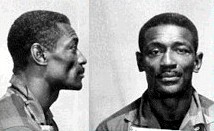The Story of Lonnie Craft AKA “Battling Blackjack”: From the Boxing Ring to the Electric Chair – He Boxed to the End!
 By Andrew “Drew The Picture” Hames
By Andrew “Drew The Picture” Hames
Choosing one fighter of the last 50 years to do an article on was an extremely exhausting ordeal, largely due to the plethora of archives one would have to sift through if making a concerted effort to nominate a rightful winner. The thought of the process alone nearly compelled me to iron a few wrinkles out of my brain, and send my temple to the nearest cathedral, mosque or synagogue begging for God’s mercy. For the sake of narrowing the never-ending list of great, deserving champions down to a more workable selection, I decided to focus on some of history’s less heralded champions (Forgetting of course that there were far more unheralded champions than there were established legends, and thereby making the process even longer… Great thinking Drew!), and my attention fell upon a fairly forgotten champion by the name of Vernice Lonnie Craft, known to his fans as “Battling Blackjack”…
Lonnie Craft’s true greatness didn’t exactly translate to a prominent boxing career by the standards we typically judge fighters by. In 42 career bouts, he only went 27-15, although his 19 knockouts in 27 wins did suggest that his 6’1 1/2 frame was equipped with considerable punching power. He didn’t even have a full 12-round bout on a resume that spanned from Light Heavyweight to Heavyweight. His biggest in-ring achievements were a 4th-round knockout of Wendell Gallant for the USA Arizona State Light Heavyweight title on June 8, 1949, being knocked out in the third round of a scheduled 6-round bout with the legendary Charles Burley at Madison Square Garden, and ending his career by suffering a first-round KO at the hands of Heavyweight standout Zora Folley in Clifton, Arizona on March 26, 1954 (Although he did own two decision victories over Tommy Gunns). His trials, tribulations and responses to them after his career ended went on to illustrate that the makings of a fighter are derived much more from their internal resolve than the external qualities of a stat sheet…
Like so many of us, Lonnie’s marriage was met with too many blows for even a champion to withstand, and “Battling Blackjack” soon realized he couldn’t change the cards regardless of how many times he shuffled the deck when his wife Virginia Cook filed for divorce in September of 1956, a mere 13 months after they’d been married. This was to be his third failed marriage without children, and having already lost both parents and devoted 40 years of his life to the State Of Arizona, County Of Maricopa (Born in Phoenix, Arizona on April 6, 1917), this was one loss to many for Lonnie to take without fighting till the end, and like his every pro bout, he attempted to make sure this fight would never hear the final bell…
Lonnie arrived at Dispatch Laundry, the place his soon-to-be ex-wife Virginia Cook was employed, asking her for a final sit-down for lunch at a local restaurant called the Sublett’s Cafe. Unbeknownst to Virginia Cook, he had spent the earlier portion of the day retrieving his paycheck and investing in a firearm, in the event that she were to refuse to return to him. Unaware of the fate awaiting her if she declined his request, Virginia told Lonnie “Phoenix isn’t big enough for the both of us”, and turned to walk away from him for the last time. Unfortunately, it turned out to be her last words, as Lonnie opened fire, shooting her twice in the back. As Virginia fell, Lonnie rose from his stool to fire two more shots into her body before planting two shots in his own chest area. Enraged and with nothing to lose, Lonnie emptied the clip firing aimlessly at his wife’s already lifeless body, and saved a final bullet for himself in a failed suicide attempt.
Obviously, glorifying this tragedy was not the focal point of this story, and Lonnie’s actions came with severe punishment. In fact, capital punishment. Lonnie was charged with murder in the first degree, and was ultimately sentenced to death by asphyxiation in the gas chamber. Now comes Lonnie’s moment of glory…
On March 7, 1957 in Florence, Arizona, Lonnie was sent to the gas chamber for his day of execution, only deviating from the traditional last meals and spiritual comfort offered to and accepted by most prisoners by instead requesting to be taken to his death as though it were his final fight. Lonnie entered the gas chamber donned in his boxing gloves, trunks, boxing shoes and robe, calmly heading to a final fight he knew would end in a KO he’d never get off the canvas from ever again, even reportedly firing uppercuts as his body succumbed to the deadly fumes. The two years that had passed between his official sentencing and his day of execution allowed him to mentally prepare himself for a fight many of our greatest champions would hope to be fortunate enough to never know. And if there was a Guinness Book statistic for the most “gangsta” walk down the aisle to an execution in history, Lonnie’s contribution here would’ve put the sport of boxing on the map in a big way.
The story of Lonnie Craft, among many others in the sport, taught me that a champion’s true value is determined by how steadfast he remains in fighting his fight regardless of what adversities come his way in life, even that adversity is impending death. I felt that a fallen champion like Lonnie Craft deserved the most honorable mention in that regard.
As a public service announcement, I’m currently working on a song/spoken word piece dedicated to this particular story. So if any of my readers hear it elsewhere, consider this article my public copyright.
Signing off until next time….
[si-contact-form form=’2′]

